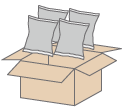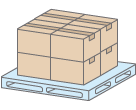Distribution Processing and Packaging
Products are naked when they are produced. In recent years, the demand for distribution processing that performs various types of work during shipping has been increasing to improve the added value of distribution. If products are transported in their naked state by airplane, ship, or truck, they may be scratched, broken, and quality may decrease. Packaging is what prevents this. This section describes the logistics functions of distribution processing and packaging.
What is Distribution Processing and Packaging?
This section describes the concepts of distribution processing and packaging, basic knowledge about the two, and their differences.
Distribution Processing

Distribution processing refers to all of the processing that is performed at the warehouse or logistics centre when shipping products. For example, grouping products into sets, applying labels, and putting products into bags, or work such as inspecting for needles, applying tags, putting products on hangers, applying price tags, and putting products into gift boxes, correspond to distribution processing.
The goal is to increase the added value of the product. There are advantages for both the customer and logistics operator. The customer is happy if this time-consuming processing is completed at the delivery stage, and the logistics operator can differentiate themselves and provide added value. In recent years, demand has been increasing due to costs because it is cheaper to perform distribution processing at a logistics centre.
Packaging to Protect Products and Quality
Products may be damaged and quality may decrease if shipped as is. The purpose of packaging is to protect the product with cardboard or wooden crates to prevent damage and a decrease in quality. With packaging, damage can be prevented due to vibrations and falls and decreases in quality can also be prevented due to mould and rot from humidity. Products can also be differentiated more easily by marking the name of the contents, volume, production date, and lot number on the cardboard box. Products with a difficult shape to carry can be easier to stack on a cart and transport if put in a cardboard box. Packaging is also effective for maintaining quality during storage.
Types of Packaging
Packaging is split into three types depending on the role and purpose: individual packaging, inner packaging, and outer packaging.




- Individual Packaging
- Individual packaging is packaging for individual products. For example, individual packaging is what is used to wrap each individual piece of candy. The purpose is to protect the product from water, humidity, light, and heat.
- Inner Packaging
- Inner packaging is used to group individually packaged products in a bag. This is the bag that is filled with individually packaged candy. Inner packaging is the unit that is sold at retail stores, and it is important to design an inner package that expresses the appeal of the product and stimulates the desire to purchase the product to promote sales.
- Outer Packaging
- Outer packaging is the unit of the largest package, such as a cardboard box or wooden crate. The main purpose is to protect the product from dirt and breakage.
Examples of Distribution Processing and Packaging
Now that we have a basic understanding of distribution processing and packaging, we will introduce some examples of how packaging is actually used. These are just few examples. Refer to the distribution processing and packaging that not only protects products but also increases additional value.
Cutting and Packaging
This distribution processing example cuts cheese to the specified number of grams and individually packages it. Cutting and packaging is performed under strict conditions in a low-temperature clean room to maintain the freshness and safety of the food.
Assortments (Packing into Sets)
This distribution processing example packages products into sets for sale, such as gift boxes for wine lovers that include chocolate, cheese, and olives.
Shrink Wrapping
This distribution processing example packages products, such as boxes of candy, toothpaste, and CD packages, with a thin film to maintain the appearance of the product and protect safety and hygiene.
Volume and Product Inspections
Volume and product inspections are performed to ensure that the contents of the product follow standards. This distribution processing example ensures safety and quality by inspecting the product when shipped. The burden of the inspection process has been increasing in recent years.
Metal Detection Inspection
This distribution processing example inspects foods with a metal detector to ensure no metal fragments contaminate the food.
Labelling
This distribution processing example creates and applies labels to the individual packaging and inner packaging.
Wrapping
This distribution processing example wraps products for events, such as Christmas, New Year's, Valentine's Day, and Halloween.
Wooden Frame Packaging
Wooden frame packaging is optimal for products that will be stored for a long time after transport and products that require ventilation. This packaging is also used for the domestic transportation and export of large machines.
Wooden Crate Packaging
Compared to cardboard, wooden crates are stronger and more resistance to rain and dust. Wooden crates are frequently used for home appliances, electronics, and glass products that are susceptible to impacts.


